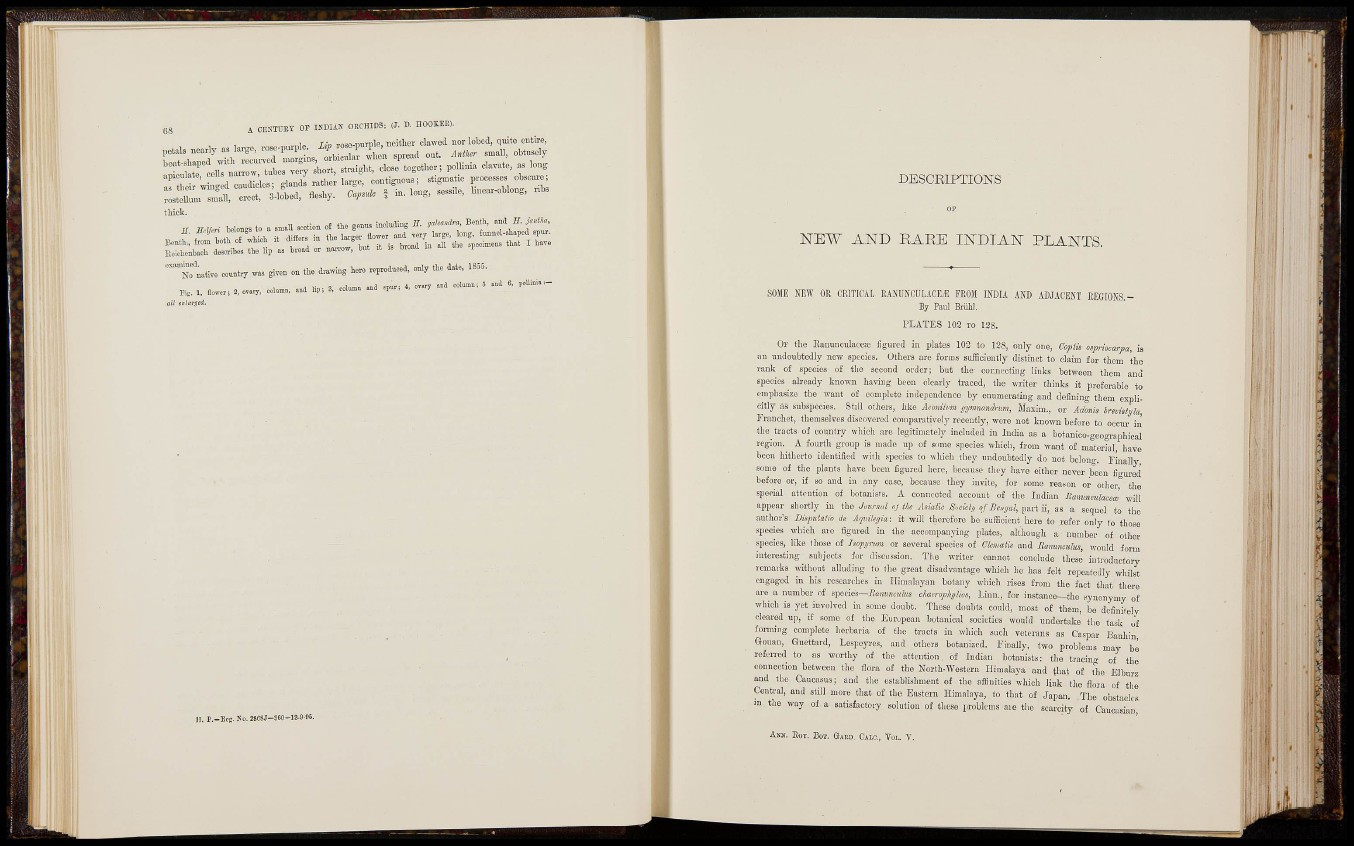
i CF.SIOIH OF I S D M ORCHIDS; (J. B. HOOKED.
„ i o n r i i i -ct. 3-lld, fieshy. Cf.uU % in. long, sess.,0, b„c.r-oblo„g, r.bs
thick.
EmctaBlatli flestiib» tt. lip n. brond ot nUOT, bot it
" ' t : - l ™ »»t r . giv.. on .he b„ . .,r.a«c.d, o.l, the d.te, ISä5.
PiK, 1. flowr; 2, OTsry, colun
all enlarged.
. nnd lip; 3, column and spur; 4, ovary «nd column; 5 and 6, poUinia:
jr. P.-Bcg. No. 2868J-860-13-8-O5.
DESCRIPTIONS
NEW" AND RARE INDIAN PLANTS.
SOME NEW OR CEIIIOiL EANUNCÜLACE« FROM ISDIi AND ADJACENT REGIOSS.-
By Paul Brühl.
P L A T E S 102 TO 128.
OP the Eanunculaceaj figured in plates 103 to 128, only one, CopUs osp>-iocarpa, is
nn undoubtedly new species. Others are forms suEGeiently distinct to claim for them the
r a n k of species of the second order; but the connecting links between them and
epecics ab-eady knowrr having been clearly traced, the writer thinks it preferable to
emphasize the want of complete independence by enumerating and defining them explic
i t ly as subspecies. Still other.s, like Atonilvm tjymmndrum, Maxim., or Admh hremtyla,
F r a n c b e t , themselves discovered comparatively recently, were not known before to occur in
t h e tracts of country which are legitimately inclnded in India as a botanico-geogriphical
region. A fonrth group is made up of some species which, from want of matcrkl, have
been hitherto identified with species to which they undoubtedly do not belong. Finally
some of the plants have been figured here, because they have either never been figured
before or, if so and in any ease, because they invite, for some reason or other the
special attention of botanists. A connected account of the Indian llanunmloEem will
appear shortly in tho Jmrmd oj the lUmtic ¡¡'.cktij af Bcgd, part ii, as a sequel to the
author's Dapuintio A Aqliitigia: it will therefore bo sufficient itere to lefer only to those
species which are figured in the accompanying plates, although a number of other
species, like those of liofijmm or several species of CtcniaUs and Ramnculm, would form
i n t e r e s t i n g subjects for discussion. Tho writer cannot coneiude these introductory
remarks ivithout alluding to the great disadvarrtage which he has felt repeatedly whilst
engaged in his researches in Himalayan botany which rises from the fact that there
a r e a number of spscies—/.'mnBtato dm'ophilm, Linn., for instance—the .synonymy of
which is yet involved in some doubt. These doubts could, most of them, bo definitelv
cleared up, if some of the Eurupean botarrical societies would rmdortake the fast Jf
f o r m i n g complete herbaria of the tracts in which such veterans as Caspar Eauhin
Gouan, Guettard, Lespoyrcs, and others botanized. Finally, two problems may be
r e f e r r e d to as worthy of tlic attention of Indian botanists: the tracino- of the
connection between the flora of the Nortb-Westcrn Himalaya and Jhat of the Elbnrz
a n d the Caucasus; and the eslafalishment of the affinities ivhich link the flora of the
Central, and still more that of the Eastern Himalaya, to that of Japan. The obstacles
m the way of a satisfactory solution of these problems are the scarcity of Caucasian,
AKN. GOT. DOT. GAUD. CALC., VOL. T.
•:ir f rl
Si '